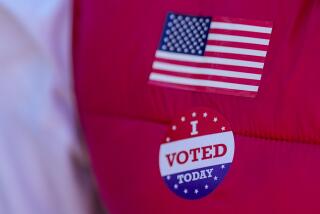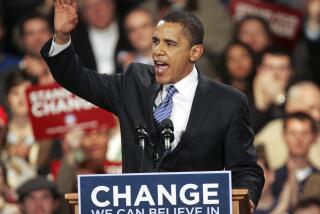Iowa’s Day of Decision: Dole, Gephardt in Lead : Democrats Expect Turnout of 100,000
DES MOINES — Nearly three years after the start of one of the most intense Democratic presidential campaigns Iowans have ever seen, caucus-goers across this heartland state will declare their choice tonight from a crowded field, narrowly led in several pre-election polls by Missouri Rep. Richard A. Gephardt.
Under the glare of hundreds of television lights and world attention, Democrats will gather at 7 p.m. in neighborhood schools, church halls and recreation rooms in 2,487 precincts to decide who will enter next week’s New Hampshire primary with the rush of victory from the first Democratic contest of the election season.
While tonight’s caucuses repre sent the kickoff of the election year, they also will bring down the curtain on the longest campaign ever in Iowa, which will send 58 delegates to the Democratic National Convention, only 1.4% of the convention’s total.
“It’s zoo-ish here,” said Gephardt spokeswoman Laura Nichols, surrounded by 200 workers in the candidate’s Des Moines headquarters. “Right now, the focus is on organization, on turning out your supporters. Everybody has blinders on, with a mission in front of them.”
Phillip Roeder, Iowa Democratic Party spokesman, predicted that 100,000 to 125,000 Democrats--a fifth of the party’s total registration here--will attend the caucuses. The top figure would represent a record turnout, but attendance could be trimmed by snow predicted for today.
Gephardt, who was languishing near the bottom of the polls just one month ago, is now struggling for first place with Illinois Sen. Paul Simon and Massachusetts Gov. Michael S. Dukakis. The congressman’s revival has come on the strength of a massive media blitz of the state, featuring commercials in which Washington insider Gephardt assumes the mantle of a Midwestern populist to denounce imports, big corporations and Eastern elites.
“Gephardt’s in a great position right now, but I really do believe it is going to go down to the wire,” said Roeder. “No one has got a lock on first.”
Gephardt Leads in Poll
A poll of likely caucus-goers published Sunday by the Des Moines Register showed Gephardt with 25%, followed by Simon with 19%, Dukakis with 15%, the Rev. Jesse Jackson and former Arizona Gov. Bruce Babbitt at 9%, former Colorado Sen. Gary Hart at 7% and Tennessee Sen. Albert Gore Jr. at 1%.
Among definite caucus-goers, Simon had the lead with 25%, followed by Gephardt with 18% and Dukakis with 17%. The poll, which had a 4% margin of error, also found that 15% of likely caucus-goers are undecided.
“When people are bunched up this closely, you predict at your own peril,” said John Law, a native Iowan and a political consultant to Babbitt.
Despite the relatively low voter participation in Iowa’s caucuses--which has led to charges that the process is unrepresentative--Iowa remains crucial to the fate of most of the major candidates. As the first major test in the Democratic race, Iowa can determine which candidate receives money, media attention and momentum heading into the later battleground states. And, just as it helps launch candidacies, it also grounds others.
Gephardt’s Effort
For Gephardt and Simon especially, Iowa will determine whether they remain in the race as serious contenders. Both come from neighboring states, and most political analysts say they need a first or second place showing to show they are serious contenders.
Gephardt has invested more time and energy in Iowa than any of his rivals and has pulled virtually his entire staff out of other states to concentrate here. However, he has been unable to pull completely away from the pack.
Simon, meanwhile, has said publicly that he plans to withdraw if he does not “do very well” in Iowa, where he has the advantage of high name recognition and media attention in the eastern part of the state, bordering Illinois.
Simon Led Earlier
Throughout much of December and as recently as early January, Simon led the polls here. But his domination of the polls proved to be short-lived. He was slow to defend himself when his opponents began challenging the sincerity of his promises to balance the budget in three years while creating huge new social programs. When he did bring forth a plan, which included raising taxes for the wealthy, the attacks had already taken a political toll.
Yet Simon now appears to be making a bit of a comeback. He lost his early lead in part to Hart’s re-entry, but his support now seems to have bounced back as Hart has dropped in the polls. The Illinois senator also touts his Jan. 31 endorsement by the Des Moines Register, the state’s largest newspaper.
Dukakis has tried hard to downplay expectations of a good showing, despite his consistently high approval ratings in surveys here. The Massachusetts governor is clearly hoping to come in close to the top in Iowa, and then score a big victory in his neighboring state of New Hampshire. But if he fails to come in second or a close third in Iowa, his huge lead in New Hampshire could be trimmed by the challenger who leaves here riding the momentum and media wave of victory.
A Scattershot Campaign
Babbitt, who has won lavish praise from the national media but scant attention from Iowa voters, will have beaten the expectations game if he comes in third. But his low approval rating may have declined even further in recent days, political analysts believe, since he began a scattershot negative campaign against all of the front-runners.
Although the race is still too muddled to tell who will win, one thing now seems fairly certain--Hart is on a slide. Hart, trying to put the Donna Rice affair behind him, re-entered the race in December and jumped to the top of the polls. But he faded fast in those surveys after mediocre performances in the presidential debates and controversy over his campaign finances.
Jackson, who in 1984 campaigned two days in Iowa and captured only 1.5% of the Democratic support, has drawn large, exuberant crowds in 61 days of campaigning here since January, 1987. Over the final weekend, his campaign launched television commercials that featured comedian Bill Cosby, an avid Jackson supporter and financial backer, exhorting Democrats to back Jackson.
The civil rights activist seems to have attracted impressive support, including many white voters new to the caucus process, but doubts persist about his campaign’s ability to turn them out on caucus night.
Strong Base in South
A double-digit percentage return would be considered a victory for Jackson in this virtually all-white state, providing evidence of an ability to expand beyond his traditional black constituency. Although a poorer showing might reinforce his image as a candidate of narrow appeal, it would not doom his campaign. Jackson has national appeal and a strong base in the South.
“I don’t think Jesse needs anything in Iowa,” Law noted. “But if he gets into double digits, it says there is such a thing as a Rainbow Coalition.”
Gore pulled most of his staff out of Iowa in November after polls showed him trailing in the state. Portraying himself as the only moderate in the race, he charged that the caucuses are unrepresentative and dominated by liberal special-interest groups out of sync with the rest of the country.
After conceding Iowa, the Tennessee senator turned his efforts to the South and managed to remain in the spotlight by piling up endorsements of Southern public officials. He recently attempted to distract the media from Iowa by gloating about the warmer weather in the South and chartering a jet to ferry reporters from frigid Iowa to balmy Florida. But most reporters chose the hotter story in the colder climate and remained behind. Indeed, Gore’s campaign has been almost invisible in the national media during these last frantic days in Iowa.
Awaiting Super Tuesday
Gore is clearly hoping that Iowa does not produce a strong front-runner this year. Although still campaigning in New Hampshire, he is staking his candidacy on the March 8 Super Tuesday Southern primaries. But if one candidate wins the early contests, Gore may face an uphill struggle to hold onto his Southern base against a newly crowned front-runner.
Two calculations will be made of the Democratic caucus results today. One, by a consortium of news organizations, will attempt to report how the voters initially voice their preferences at the beginning of the complex caucus process. The Democratic Party will report later on how the delegates are likely to be allocated.
At each precinct caucus, a candidate must have at least 15% of those in attendance to claim delegates. A group that fails to meet this threshold must disband and either go with a second-choice candidate or vote “undecided.”
So the campaigns are working hard to persuade voters who won’t support them initially to at least consider them as a second-choice alternative. In such a close race, whichever candidate is the second choice of the most voters could win, observers say.
‘Was Really Worried’
“I was really worried a few days ago, when it looked like Simon was really dropping, that he might go below threshold and all his people might go to Dukakis and give Dukakis a win,” said David Doak, Gephardt’s media consultant.
Because of the second-choice factor, negative campaigning is dangerous politics in Iowa; a bitter attack risks alienating a rival’s supporters. But that risk has not stopped the Democrats here so far.
Indeed, most of the major candidates have gone on the assault in the closing weeks of the campaign to try to break out of the pack. After falling in the polls, Simon desperately tried to regain his lead by hammering away at the rising Gephardt.
At news conferences, in debates and in a last-minute radio campaign, Simon has accused Gephardt of flip-flopping on key issues, including tax reform and aid to farmers.
Babbitt, whose low standing in the polls gives him little to lose, has been the most outspoken in his criticism of his rivals. During a three-day stretch last week, Babbitt took on each of his main competitors one at a time--Simon one day, Dukakis the next, and Gephardt the third. Babbitt, who supports a national sales tax to reduce the deficit, charged that his opponents were lying about the need for a tax hike.
Turning Out Voters
Organization is the key to turning out caucus voters, and Gephardt, Dukakis, Babbitt and Simon all have strong field staffs to get out their supporters. Each of their campaigns will run fleets of buses and vans tonight to take supporters to caucus, and car pools will be arranged even in isolated, rural areas. Campaign staffs in college towns are organizing beer parties with rock bands to lure students to vote.
A high turnout would most likely benefit Gephardt because he has staged the most recent surge and has attracted new supporters who are not used to attending caucus. “If the turnout’s low,” said Joseph Trippi, Gephardt’s deputy campaign manager, “I think we have a good chance of winning by a tight margin. But I’d be much more confident about winning it with a high turnout.”
Simon and Dukakis, whose supporters tend to be faithful caucus-goers, probably would benefit from a smaller turnout. Babbitt has said publicly that he thinks a low turnout would be good for his campaign too because he has a solid, albeit small, base of support that would show in any weather.
A last-minute media blitz by all of the major campaigns may also play a pivotal role in deciding the outcome. In an effort to woo the sizable block of undecided caucus-goers, the Democrats have plastered the state’s airwaves with commercials in the closing days.
Iowa Gets Set to Vote THE STATE Population: 2,851,000 (1986 est); 58.6% urban, 41.4% rural. Racial/ethnic makeup: 97.4% white, 1.4% black. Latinos, Asians, American Indians less than 0.5% each. Major cities: Des Moines (capital), 191,000; Cedar Rapids, 110,000; Davenport, 103,000 Economy: Dominated by agruculture and agriculture-related manufacturing industries. Other major manufacturing: tires, appliances, electronic and automotive products. Registered voters (1986): 1,611,438. Democrats 35%, Republicans 31%, Independents 34%. THE CAUCUSES Tonight at 7 p.m., Democrats and Republicans meet separately in nearly 2,500 precincts around the state to begin a four-step process of choosing delegates to the national conventions. The actual delegates are not chosen until June, but the caucuses weigh heavily in determining the amount of support each presidential candidate ends up with. THE REPUBLICANS Anyone of voting age who lives in the precinct can participate in the GOP caucuses. They need not be registered Republicans, or even registered to vote. Results will be available relatively early on caucus night, because the first order of business will be a secret-ballot straw poll, in which each caucus-goer votes for his or her preferred candidate. THE DEMOCRATS Participants must be registered Democrats--or they can register as they come in. The Democrats’ process is more complicated--and more public--than the Republicans’. At each caucus, participants must form groups for the candidate of their choice, or form a separate “uncommitted” group. Then, any group composed of less than 15% of those in attendance must disband. The surviving groups are then counted, and delegates to the next step of the process--99 county conventions--are apportioned accordingly. The Democratic vote will be announced in two ways, the percentage of county delegates awarded to each campaign, followed by the raw vote total from each precinct.
More to Read
Get the L.A. Times Politics newsletter
Deeply reported insights into legislation, politics and policy from Sacramento, Washington and beyond. In your inbox three times per week.
You may occasionally receive promotional content from the Los Angeles Times.











